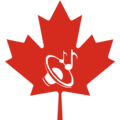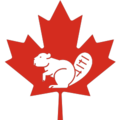
Back بوابة:كندا Arabic Portal:Kanada Azerbaijani پوْرتال:کانادا AZB Партал:Канада BE-X-OLD Портал:Канада Bulgarian دەروازە:کەنەدا CKB Portál:Kanada Czech Portal:Kanada German Portal:Kanada DIQ Portal:Canadá Spanish
| Showcase | Contents | Contributing |
Introduction
Canada is a country in North America. Its ten provinces and three territories extend from the Atlantic Ocean to the Pacific Ocean and northward into the Arctic Ocean, making it the world's second-largest country by total area, with the world's longest coastline. Its border with the United States is the world's longest international land border. The country is characterized by a wide range of both meteorologic and geological regions. With a population of over 41 million people, it has widely varying population densities, with the majority residing in urban areas and large areas of the country being sparsely populated. Canada's capital is Ottawa and its three largest metropolitan areas are Toronto, Montreal, and Vancouver.
A developed country, Canada has a high nominal per capita income globally and its advanced economy ranks among the largest in the world by nominal GDP, relying chiefly upon its abundant natural resources and well-developed international trade networks. Recognized as a middle power, Canada's support for multilateralism and internationalism has been closely related to its foreign relations policies of peacekeeping and aid for developing countries. Canada promotes its domestically shared values through participation in multiple international organizations and forums. (Full article...)
Featured article -
The Wells Gray-Clearwater volcanic field, also called the Clearwater Cone Group, is a potentially active monogenetic volcanic field in east-central British Columbia, Canada, located approximately 130 km (81 mi) north of Kamloops. It is situated in the Cariboo Mountains of the Columbia Mountains and on the Quesnel and Shuswap Highlands. As a monogenetic volcanic field, it is a place with numerous small basaltic volcanoes and extensive lava flows. (Full article...)
Current events
- May 15, 2025 – 2025 Canadian wildfires
- Two people are killed and more than 1,000 others evacuate after wildfires spread across central Manitoba, Canada. (Euronews)
- May 1, 2025 – 2025 Southwest United States measles outbreak
- North America's three largest measles outbreaks continue to expand, with over 2,500 confirmed cases. There have been three fatalities in the United States and one in Mexico. The outbreaks began in Ontario, Canada, then surged in Texas and New Mexico, and have quickly escalated in Chihuahua, Mexico. (AP News)
- April 28, 2025 – 2025 Canadian federal election
- Voters in Canada go to the polls to elect the 343 members of the House of Commons to the 45th Canadian Parliament. (BBC)
- The Liberal Party under leader Mark Carney is projected to form government for the party's fourth consecutive mandate, with Carney remaining prime minister. (The Globe and Mail)
- Conservative Party leader Pierre Poilievre and New Democratic Party leader Jagmeet Singh lose their seats, with the NDP also losing official party status in the House. Each make speeches conceding the election, with Singh announcing his intention to resign as party leader. (CTV News)
- April 27, 2025 – 2025 Vancouver car attack
- The death toll from yesterday's vehicle-ramming attack at a street festival in Vancouver, British Columbia, Canada, rises to eleven with at least 20 others injured, making the attack tied for the deadliest vehicle-ramming attack in Canadian history. The British Columbia Prosecution Service charges the perpetrator with eight counts of second-degree murder, while investigators also rule out terrorism. (CTV News) (AP)
Selected panorama -
National symbol -

An inuksuk (plural inuksuit) or inukshuk is a type of stone landmark or cairn built by, and for the use of, Inuit, Iñupiat, Kalaallit, Yupik, and other peoples of the Arctic region of North America. These structures are found in northern Canada, Greenland, and Alaska. This combined region, north of the Arctic Circle, is dominated by the tundra biome and has areas with few natural landmarks. (Full article...)
Selected vital article -
Canada has ten provinces and three territories that are sub-national administrative divisions under the jurisdiction of the Canadian Constitution. In the 1867 Canadian Confederation, three provinces of British North America—New Brunswick, Nova Scotia, and the Province of Canada (which upon Confederation was divided into Ontario and Quebec)—united to form a federation, becoming a fully independent country over the next century. Over its history, Canada's international borders have changed several times as it has added territories and provinces, making it the world's second-largest country by area. (Full article...)
Selected picture -
Featured biography -
Sir John Alexander Macdonald PC GCB QC (10 or 11 January 1815 – 6 June 1891) was the first prime minister of Canada, serving from 1867 to 1873 and from 1878 until his death in 1891. He was the dominant figure of Canadian Confederation, and had a political career that spanned almost half a century. (Full article...)
Did you know -

- ... that during combat, the Canadian-designed SW1C radar failed to find not only its U-boat target, but also an iceberg near the ship?
- ... that Canadian artist Tom Forrestall spent six months painting his own car?
- ... that Canadian surgeon Robin McLeod advocated for post-operative patients to get back on their feet and move around immediately, against the prevailing guidance that they should stay in bed?
- ... that Saulteaux linguist Margaret Cote was the first person in Saskatchewan to teach a First Nations language in a public school?
- ... that Canadian architect Barry Downs contributed to the redevelopment of the Expo 86 site in Vancouver, the largest private development in North America at the time?
- ... that there is an East Quoddy Head Lighthouse and a West Quoddy Head Lighthouse on opposite sides of a bay, but one is in Canada and the other is in the United States?
- ... that in 1858, when 400 Black Americans experiencing discrimination in California resettled on Vancouver Island, clergyman Edward Cridge integrated Christ Church to welcome them?
Featured list -
Canada's national parks are protected areas under the Canada National Parks Act, owned by the Government of Canada and administered for the benefit, education, and enjoyment of the people of Canada and its future generations. National parks are administered by Parks Canada, a Crown agency operating under the jurisdiction of the Ministry of Environment and Climate Change. The goal of the national parks system is to set aside lands representing the country's 39 distinct natural regions described in the National Parks System Plan, primarily to protect the ecological integrity of the land, and secondarily to allow the public to explore, learn about and enjoy Canada's natural spaces. (Full article...)
Canadian content search
Associated Wikimedia
The following Wikimedia Foundation sister projects provide more on this subject:
-
Commons
Free media repository -
Wikibooks
Free textbooks and manuals -
Wikidata
Free knowledge base -
Wikinews
Free-content news -
Wikiquote
Collection of quotations -
Wikisource
Free-content library -
Wikiversity
Free learning tools -
Wikivoyage
Free travel guide -
Wiktionary
Dictionary and thesaurus
© MMXXIII Rich X Search. We shall prevail. All rights reserved. Rich X Search





























